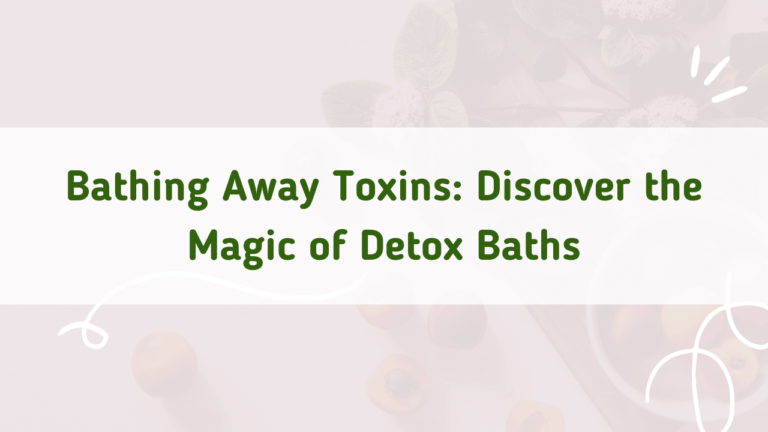The Power of Detox For Inflammation: An All-Natural Approach

In our brisk world, processed foods have seeped into our everyday meals.
While handy and often palatable, these foods bear a significant drawback: they can stimulate chronic inflammation, a systemic issue linked with numerous enduring diseases.
Chronic disease due to inflammation can sabotage a robust immune system, leading to various health challenges, such as heart disease and elevated blood pressure.
The silver lining is that we can curtail inflammation and bolster the body’s natural detox processes via alterations in diet and lifestyle.
This article delves into an anti-inflammatory lifestyle tailored to diminish inflammation, fortify healthy blood sugar levels, and enhance overall wellness.
Contents
- 1 Why Detox for Inflammation?
- 2 The Anti-Inflammatory Detox Diet: What to Eat and What to Avoid
- 3 Anti-Inflammatory Diet: A One-Day Example
- 3.1 Breakfast: Mixed Berry and Greek Yogurt Parfait
- 3.2 Mid-Morning Snack: Almond Butter and Apple
- 3.3 Lunch: Chicken Salad with Leafy Greens
- 3.4 Afternoon Snack: Celery and Carrot Sticks with Hummus
- 3.5 Dinner: Grilled Salmon Served with Steamed Broccoli and Quinoa
- 3.6 Evening Snack: Herbal Tea and Dark Chocolate
- 3.7 The Final Takeaway
- 4 FAQ
- 5 How do I detox my body from inflammation?
- 6 What is the fastest way to flush inflammation?
- 7 What drink kills inflammation?
Why Detox for Inflammation?
The presence of inflammatory markers within our body indicates the dispatch of signals from white blood cells in retaliation to harmful chemicals, toxins, or injuries.
While this inflammatory response is indispensable for survival, complications ensue when inflammation becomes chronic.
Chronic inflammation is linked with numerous prolonged diseases, such as cardiovascular disease, cancer, and autoimmune disorders.
One prominent trigger of chronic inflammation is the standard Western diet, which is saturated with processed foods, vegetable oils, and unhealthy fats.
An anti-inflammatory diet plan aims to mitigate chronic inflammation by endorsing the intake of foods recognized for their anti-inflammatory attributes while discouraging foods that instigate inflammation.
This dietary transition can diminish inflammation, stabilize blood pressure and blood sugar levels, and fortify the immune system.
The Anti-Inflammatory Detox Diet: What to Eat and What to Avoid
An anti-inflammatory diet transcends fleeting trends or instant remedies. Let’s delve into the specifics:
Foods to Eat
Leafy Green Vegetables: Regarded as the food world’s superheroes, spinach, kale, collard greens, and Swiss chard overflow with antioxidants, compounds safeguarding your cells against damage. They also boast abundant Vitamin K, aiding in regulating the body’s inflammatory process. Remember to weave in some greens when you plan your next meal!
Fatty Fish: Omega-3 fatty acids found in fatty fish such as salmon, mackerel, sardines, and trout are potent inflammation antagonists. Consuming these fish results in your body metabolizing the Omega-3s into compounds named resolvins and protectins, known for their anti-inflammatory properties. Regular intake of fatty fish can mitigate the inflammation associated with conditions like heart disease.
Olive Oil: A cornerstone in any healthy kitchen, olive oil teems with oleocanthal, which mirrors the anti-inflammatory effects of ibuprofen, a commonly used anti-inflammatory drug. Swap those unhealthy fats for olive oil, which will benefit your body.
Fruits: Certain fruits, especially berries (strawberries, blueberries, raspberries) and cherries, are loaded with natural antioxidants and polyphenols—protective compounds with anti-inflammatory properties. These not only combat inflammation but also significantly boost your immune system.
Nuts and Seeds: Almonds, walnuts, and seeds like flaxseeds and chia seeds are high in healthy fats and fiber and offer a good source of antioxidants, all of which can rein in inflammation. Therefore, tossing in a handful of nuts or showering seeds over your meal can contribute immensely to your health!
Turmeric and Ginger: These spices have long been cherished for their medicinal properties. Turmeric contains curcumin, and ginger houses gingerol, both potent anti-inflammatory compounds. Infusing these spices into your dishes not only augments flavor but also aids in inflammation reduction.
Foods to Avoid
While some foods can help suppress inflammation, others instigate or exacerbate it. These include:
Processed Foods: Numerous processed foods are crammed with additives, preservatives, and synthetic ingredients perceived as “alien” by your body. This could trigger an immune response, inciting an inflammatory reaction. It’s akin to your body’s defense mechanism overreacting, causing more harm than benefit.
Vegetable Oils: Vegetable oils, like corn and soybean oil, are high in omega-6 fatty acids. While omega-6 is vital for the body, the Western diet overindulges and under-consumes omega-3. This imbalance can instigate inflammation. Hence, while it’s not about wholly excluding omega-6, striving for a balanced omega-6 to omega-3 ratio is crucial.
Sugary Drinks: Sugary beverages can trigger a surge in blood sugar levels. To counteract this, your body produces insulin. If this happens repeatedly, it can lead to insulin resistance and inflammation. It’s advisable to stick with water, unsweetened tea, or naturally flavored waters instead.
Refined Carbs: Foods such as white bread, pastries, and many processed foods are replete with refined carbohydrates. These can cause a spike in blood sugar and insulin levels, inducing an inflammatory response. Opt for whole grains over refined ones for a healthier alternative.
Anti-Inflammatory Diet: A One-Day Example
Meal planning can simplify adherence to an anti-inflammatory diet. Here’s a model of a comprehensive, single-day menu brimming with delicious and wholesome foods that can aid in reducing inflammation:
Breakfast: Mixed Berry and Greek Yogurt Parfait
Begin your day with a dish of Greek yogurt layered with mixed berries packed with antioxidants. Top it with a dash of ground flaxseed for extra fiber and beneficial fats. Here’s the method:
- 1 cup of Greek yogurt
- 1/2 cup of mixed berries (like blueberries, raspberries, and strawberries)
- 1 tablespoon of ground flaxseed
- Optional: For a subtle touch of sweetness, drizzle a teaspoon of honey on top
Mid-Morning Snack: Almond Butter and Apple
A small apple paired with a tablespoon of almond butter makes for a satisfying and nutritious snack. The apple provides fiber and hydration, while the almond butter delivers healthy fats and protein.
Lunch: Chicken Salad with Leafy Greens
A hearty salad for lunch can be an optimal strategy to incorporate several servings of anti-inflammatory foods. Here’s an example:
- 2 cups of mixed leafy greens (like spinach, kale, and arugula)
- 1 grilled chicken breast, sliced
- 1/2 of an avocado, diced
- 1/2 cup of cherry tomatoes
- 1/4 of a cucumber, sliced
Dressing made with 2 tablespoons of extra virgin olive oil, the juice of one lemon, and a dash of salt and pepper
Combine all the ingredients, and you’ve got a refreshing, nutrient-dense meal that should keep you full for hours.
Afternoon Snack: Celery and Carrot Sticks with Hummus
Snacking on raw veggies with hummus is a tasty and straightforward way to weave more anti-inflammatory foods into your diet. The hummus also provides protein to help you stay satiated until dinner.
- 1 medium carrot, cut into sticks
- 1 celery stalk, cut into sticks
- 2 tablespoons of hummus for dipping
Relish this light yet filling snack as an afternoon boost. It’s about pleasing your palate while enriching your diet with nutrient-rich choices.
Dinner: Grilled Salmon Served with Steamed Broccoli and Quinoa
Consider grilled salmon, rich in inflammation-fighting omega-3 fatty acids, for dinner. Couple it with steamed broccoli, one of the most nutrient-dense veggies, and a side of quinoa, a grain teeming with fiber and protein:
- 1 salmon fillet, grilled
- 1 cup of steamed broccoli
- 1/2 cup of cooked quinoa
Flavor your salmon with a dash of olive oil, lemon juice, and herbs of your choice. Similarly, season your broccoli and quinoa with a hint of olive oil and a pinch of salt.
Evening Snack: Herbal Tea and Dark Chocolate
Wrap up the day with a cup of your favorite herbal tea and a piece of dark chocolate packed with antioxidants. This combo can satisfy any late-night sweet cravings while aiding your body in fighting inflammation:
- 1 cup of herbal tea (such as chamomile or peppermint)
- 1 small piece of dark chocolate (minimum 70% cocoa)
This menu is merely indicative, but it showcases how simple and enjoyable it can be to integrate anti-inflammatory foods into every meal of your day. Tweak portions and specific food choices to match your tastes and nutritional needs.
The Final Takeaway
Embracing an anti-inflammatory lifestyle extends beyond merely reshaping your diet. It incorporates regular physical exercise, sufficient sleep, stress control, and abstaining from smoking and excessive alcohol consumption.
These lifestyle changes can assist in reducing inflammation, resulting in a body detox and minimizing the risk of chronic diseases.
Keep in mind that everyone’s nutritional requirements vary. Before starting an anti-inflammatory diet or any fresh health regimen, seek advice from your doctor or nutritionist.
In collaboration, you can devise a dietary plan that caters to your needs while alleviating inflammation and enhancing overall wellness.
FAQ
How do I detox my body from inflammation?
You can detox your body by adopting an anti-inflammatory diet, maintaining regular physical activity, ensuring adequate sleep, and effectively managing stress.
What is the fastest way to flush inflammation?
The fastest way to flush inflammation involves consuming anti-inflammatory foods, removing inflammatory foods, staying physically active, and maintaining proper hydration.
What drink kills inflammation?
Drinks such as green and turmeric are effective due to their high antioxidant content.

Rahul is a nutritionist and personal trainer with 3+ years of experience in the field of health coaching. He specializes in nutrition science, with a keen eye for how food choices, lifestyle habits, and physical activity impact our bodies.






